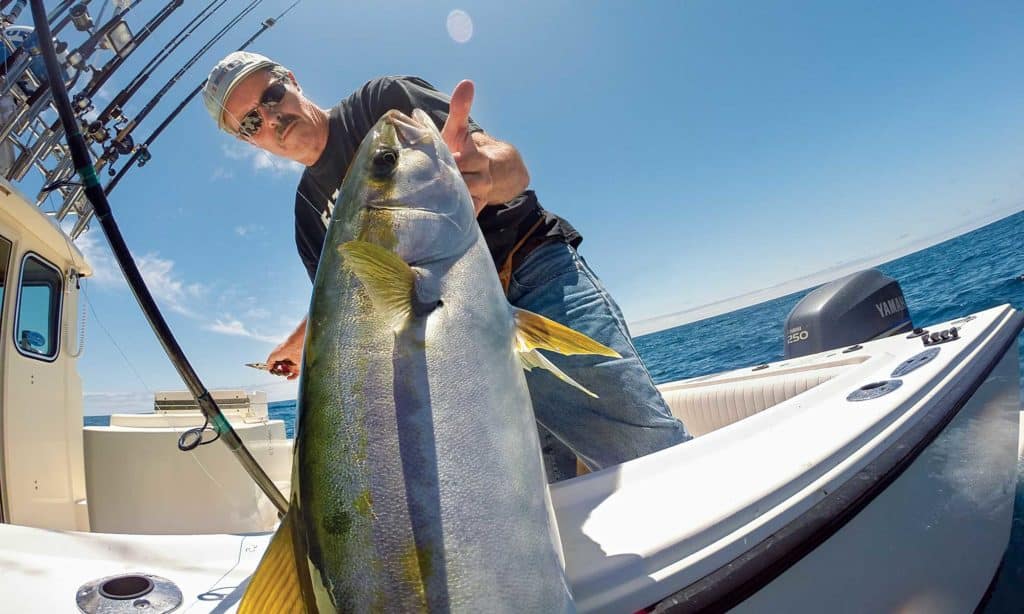
The offshore season started for me last year in early June as I steamed toward Santa Catalina Island, 30 miles off the coast, to target rockfish. Halfway there, we spotted a patch of floating kelp about the size of a garage door, so I altered course to idle by and peer underneath.
“Hold on!” I barked as I caught sight of a squadron of the big jacks. “Get a bait out! Now!” We cast live sardines toward the weeds, and the yellows immediately launched an attack. We found ourselves with a triple hookup, passing bent rods over and under to avoid tangles, and taking turns gaffing each other’s fish. Soon a trio of 20- to 25-pounders lay on the deck.
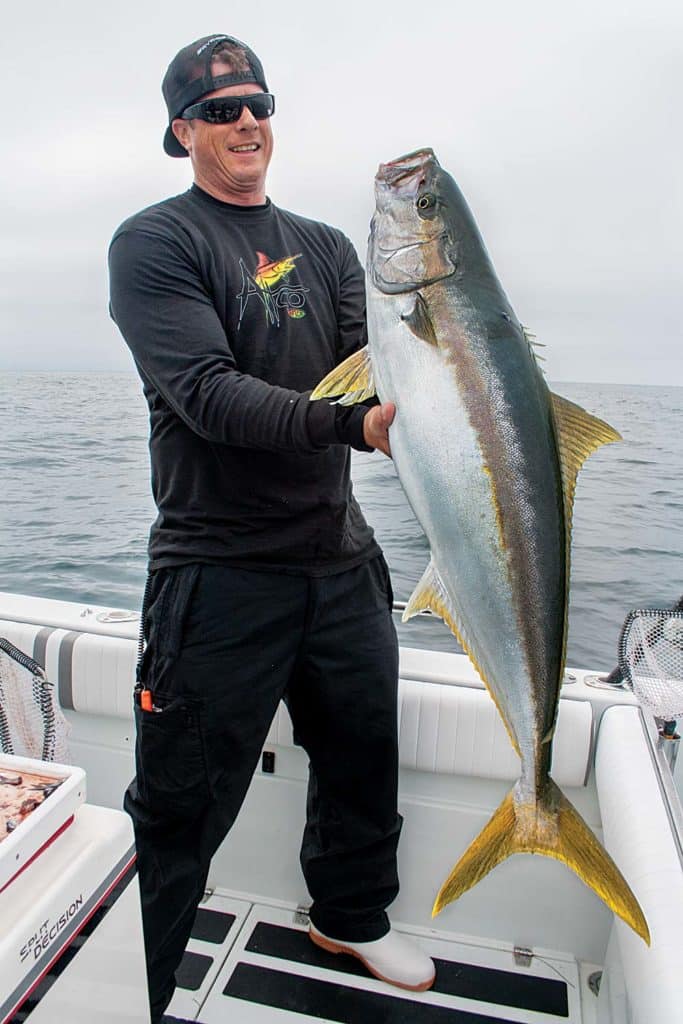
Floating Oasis
It’s all about finding the right patch of kelp. Torn loose from forests of giant kelp by waves, clumps of these weeds — called paddies — create an oasis in a desert of blue. With the onset of summer, schools of California yellowtails haunt these shadowy outposts, following the baitfish seeking shelter in the kelp.
Food might not be the only factor attracting yellowtails to paddies; some believe they gather here to spawn. Large aggregations have been spotted under kelp, and while only some are willing to bite, there usually are enough takers to motivate anglers to go paddy-hopping.
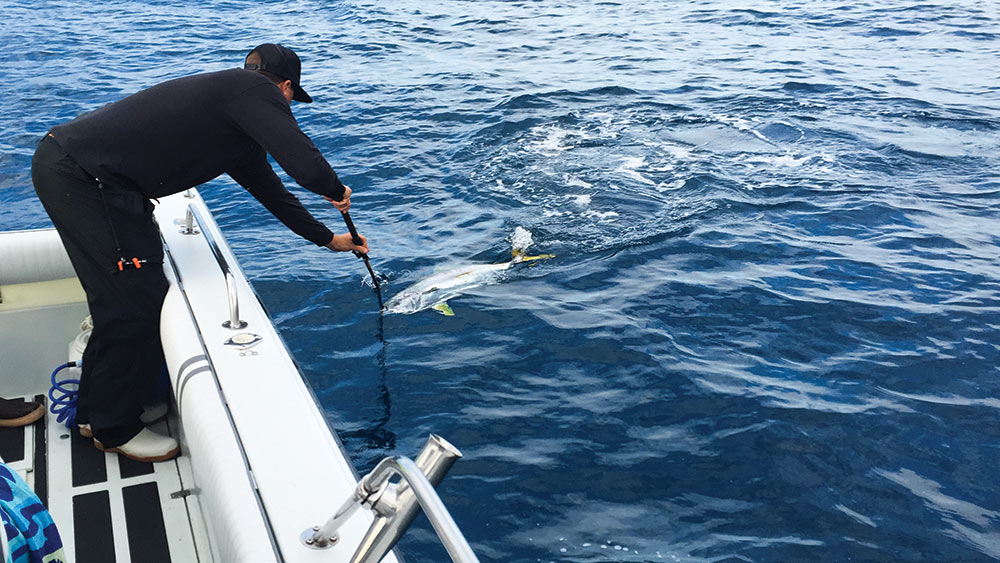
Search Party
Before you can fish for yellows under a paddy, you need to find a paddy. It’s not always easy, especially when overcast skies fade the ocean’s surface to a monochromatic gray.
Astute anglers cruise at no more than 15 mph, or troll at about 8 mph, while searching for a paddy. Having the whole crew scanning the water maximizes coverage, and a tower also helps spot kelp at a distance. Gyrostabilized binoculars extend the search radius out to a mile or more.
Other cues can also lead you to productive kelp. Gulls and terns resting atop the floating mass are often visible before you see the paddy itself. This might be a sign that there are fish underneath. Terns flitting above the paddy are a sure sign that predators lie below.
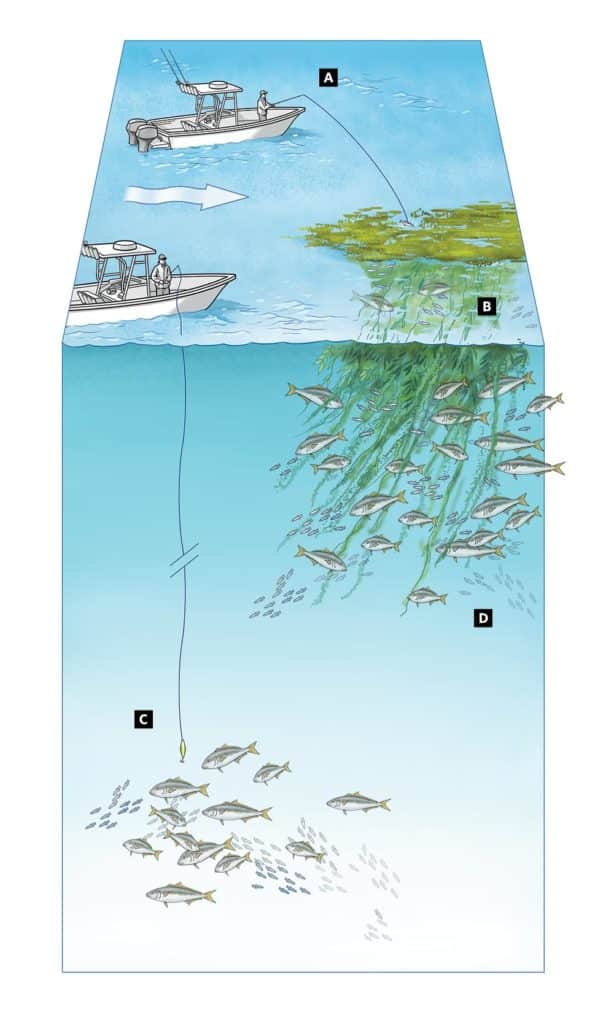
[B] A well-presented live bait draws the attention of yellowtails near the surface or holding in the kelp fronds.
[C] If the fish are deep, drop a metal jig down as far as 200 feet to garner strikes.
[D] Yellowtails hang in the kelp fronds, just under the surface, for cover and forage. Steve Sanford
Preferred Paddy
Certain paddies tend to attract more fish than others. A few stringers of kelp seldom hold fish, but a paddy the size of a trash-can lid may be worth a stop, especially if it has stringers draping below the main canopy, which attract bait. A paddy the size of a mattress or garage door promises a community of marine life. This is the dream paddy. I’ve found as many as 100 yellowtails schooling below such patches.
Water color also plays a role. A paddy in green water, close to shore, doesn’t attract yellowtails as well as one in clear, blue water. Due to upwellings, which attract baitfish and create the eddies that concentrate the kelp, paddies floating above underwater ridges or seamounts, such as the 14-mile bank, 209, 277 and 182, produce more fish than those found drifting over a featureless bottom.
Approach Pattern
In the excitement of finding a paddy, resist the urge to rush in and start fishing. There are days when yellowtails will rush out to greet you. But a stealthy approach pays off, especially when the fish are more reclusive.
I like to shut down about 50 feet upwind, then drift by about 25 feet from the kelp, on the sunny side, to spot fish hanging underneath the paddy.
Aggressive yellowtails will bite a lively sardine, Pacific mackerel or jack mackerel readily; on weekends and holidays, when boat pressure is high, they play hard to get. But there’s a few tricks to get them in the right mood.
Throwing out some live baits as chum whets their appetite. Sometimes they show little interest until a hookless livey moving swiftly motivates them. That’s when you want to get a hooked bait in the water. Reeling a live bait quickly back to the boat will sometimes earn you a bite.
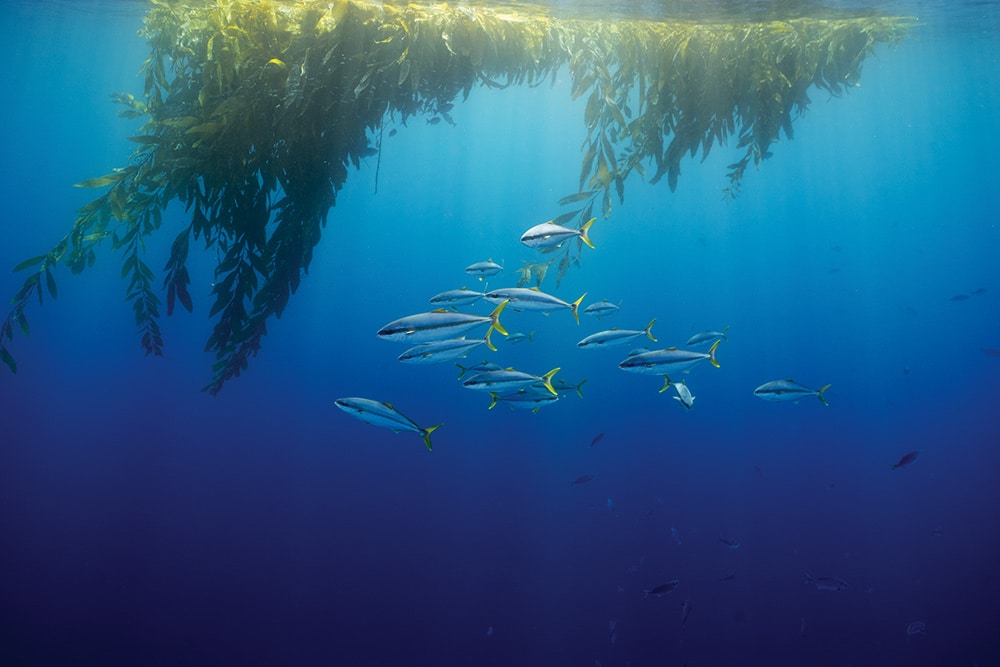
The same holds true of yellowtails that retreat to the depths as you approach. In this case, dropping a heavy metal jig (known as a yo-yo iron) such as a Tady 9/0 or Salas 6X Jr. (blue-and-white patterns seem to work best) 200 feet down, then retrieving it as fast as you can might trigger a strike. With this technique, it’s important not to swing the rod when you’re bit. Instead, keep reeling until the hooks set and line pours off the reel, then raise the rod to battle the fish.
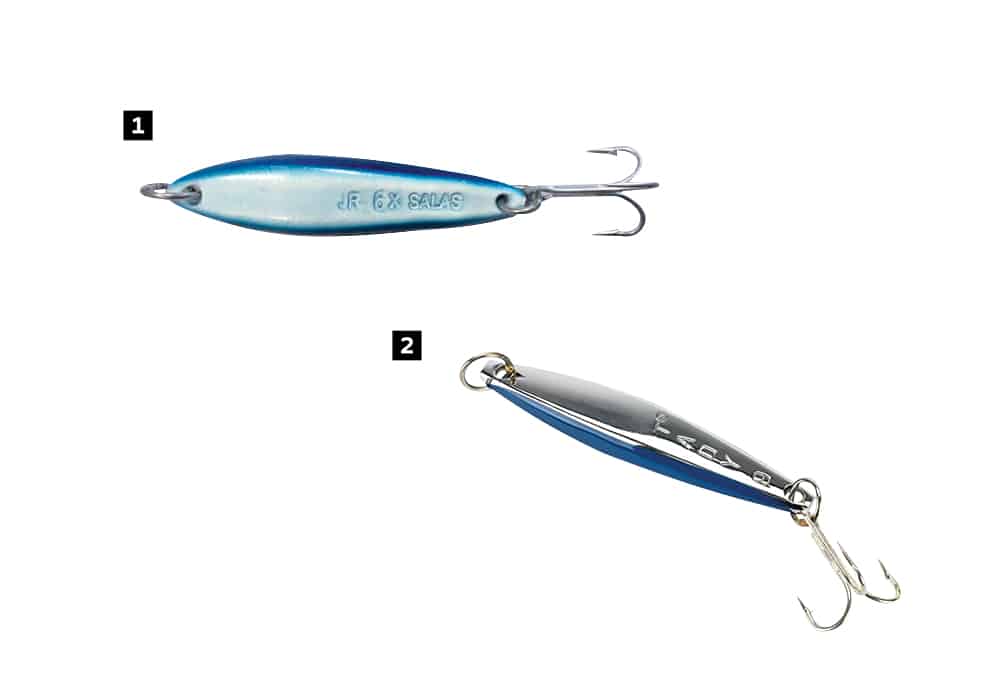
[2] An effective classic, the Salas 6X Jr. remains a favorite among yellowtail hunters. Courtesy Tady, Salas
New Offering
Sometimes a yellowtail or two will hover directly under the paddy, backs brushing the fronds, refusing to budge or bite. In this case, a change-up might draw a strike. If you’re free-lining live sardines, switch to a frisky Pacific mackerel.
Cast the bait to the edge of the paddy to get the otherwise disinterested yellow excited enough to strike, or cast the mackerel on top of the paddy, then pull it off like pulling a frog off a lily pad. This often provokes an explosive strike.
If you don’t catch any yellows under a paddy within 10 or 15 minutes, move on and search for another. You might want to circle back later in the day. Yellowtails are known to roam, and it’s not unusual to find fish in the afternoon under a paddy that was dry in the morning.
Fight Plan
California yellowtails know kelp means safety, so a hooked fish immediately turns toward the paddy. A big, powerful yellowtail is difficult to stop on the first run, and many are lost when the fish plunges into the weeds. Kelp looks soft, but the fronds are studded with sharp-shelled critters that chafe and cut monofilament.
Opt for 50- to 65-pound coated braid with a short trace of fluoro leader. As the yellowtail swims through the kelp, the braid acts like a saw, cutting through the fronds. If you’re craving an early-season bluewater trip off the coast of Southern California, get out there and hunt up some weeds. You just might find a gang of bruiser yellowtails ready to bite.
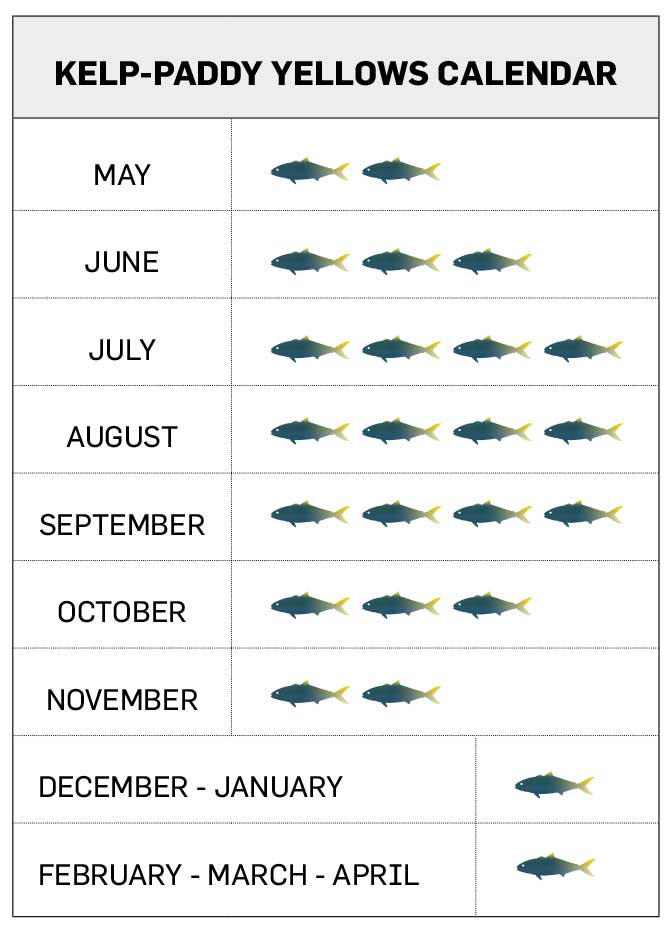
SWS Planner
What: California yellowtails
Where: SoCal offshore waters, from Point Conception to below the Mexican border
When: Spring through fall
Who: Anglers with reliable craft from 20 feet up. A number of Southern California charters and guide services can show you secrets to kelp-paddy yellowtails.
Capt. Barry Brightenburg
Always an Adventure Charters
619-540-8944
alwaysanadventurecharters.com
Capt. Dave Hansen
Your Saltwater Guide
949-374-0786
yoursaltwaterguide.com
Capt. Jaime Thinnes
Seasons Sportfishing
714-206-6146
seasonssportfishing.com
SWS Tackle Box
Rods: 7- to 8-foot conventional, rated for 25- to 40-pound line
Reels: Small- and medium-size lever-drag reels
Line: 50- to 65-pound coated braid with 1 to 2 feet of 25- to 40-pound fluoro leader
Terminal Rigs: Free-lining: 3/0 to 5/0 Owner Gorilla Light hooks matched to bait. Hook the bait crosswise through the nose or through the roof of the mouth and out the top.
Yo-yo fishing: Tady 9/0 or Salas 6X Jr. in blue-and-white patterns.









